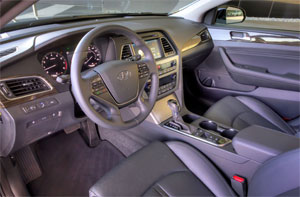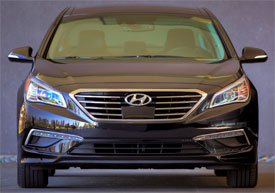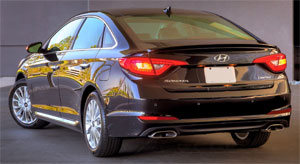2015 Hyundai Sonata
The 2011 Sonata was a watershed sedan for Hyundai. It lured buyers in with dynamic styling, and cheap prices, and kept them satisfied with great drivability and reliability. But, that was yesterday. The challenge today is to keep those buyers despite more intense mid-size competition, and to uphold their well-earned reputation. So let’s find out how an all-new 2015 Sonata measures up.
It’s difficult to fathom that the 2015 Hyundai Sonata marks the beginning of the 7th generation of the Korean middle-weight four-door. To say it has come a long way is an understatement. Evolving from a late 80’s boxy also ran, to today’s family sedan trend setter.
And it’s easy to see those trend setting ways continuing when you climb inside the latest Sonata. You’re immediately treated to a great looking interior that is incredibly comfortable and very upscale in feel. Though this Limited model’s rich 2-tone black and brown theme surely has a lot to do with that.
Not that it’s perfect. Some of our staff found the sparseness of control knobs annoying, and the few knobs that are present are either a long reach or look too similar to each other, and had some turning up the temperature when they we were trying to crank up the volume. Owners will likely figured it all out in no time, however.
 The folding rear seats offer plenty of head and leg room, and while seat cushions are a little on the hard side there is a very comfortable rake to the seat backs which makes things quite tolerable for long trips.
The folding rear seats offer plenty of head and leg room, and while seat cushions are a little on the hard side there is a very comfortable rake to the seat backs which makes things quite tolerable for long trips.
In fact, interior volume has risen enough that Sonata is now in the Large Car EPA size-class. Trunk space is certainly larger than most mid-size rivals at 16.3 cubic-ft.
An available Tech package gets you a panoramic sunroof, HID headlights, and very competent 8-inch navigation display with touchscreen. But the Ultimate package is where the tech really kicks in with smart cruise control with full stop and start capabilities, lane departure warning, forward collision warning, plus an electronic parking brake with hold feature.
As before all engines are four-cylinder and three are available. This standard, direct-injected 2.4-liter I4 rates 185-horsepower and 178 lb-ft. of torque. Peak power is actually down a little from last year in an attempt to make things more responsive. But, we found it a bit weak and noisy. A 1.6-liter turbo Eco model is new, but only recommended if fuel economy is your number-one priority. The 245-horsepower 2.0-liter turbo looks like the best choice for ample off-the line torque.
 We didn’t find that in the 2.4. Getting to 60 took us a lackluster 9.3-seconds. Well off the previous car. You do start to feel some hint of power mid-range, but slow shifts from the 6-speed automatic keep the fun factor just barely above zero. Running out the ¼-mile took 17.2-seconds at 83 miles-per-hour.
We didn’t find that in the 2.4. Getting to 60 took us a lackluster 9.3-seconds. Well off the previous car. You do start to feel some hint of power mid-range, but slow shifts from the 6-speed automatic keep the fun factor just barely above zero. Running out the ¼-mile took 17.2-seconds at 83 miles-per-hour.
Things improved somewhat through our handling course. Understeer is certainly there, but it doesn’t bombard you. Steering is quick, but the feel is artificially heavy and disconnected. Much, much better was braking performance, with solid stops from 60 that averaged just 117-feet.
This is, first and foremost, a family sedan of course, so while it’s doubtful that track performance will be high on any family’s priority list, exterior design will certainly play a much larger roll.
The fluidic sculpture 2.0 styling theme tries just as hard as the previous generation to make a statement, but we’re not sure the results are nearly as successful. Though the look, complete with LED daytime running lights and dual exhaust is now undoubtedly classier, like its better rivals. The rear appears wider and taller, with high mounted LED tail lights pointing in towards the center.
So while exterior beauty is always in the eye of the beholder, from the driver’s seat we all agree that Hyundai has certainly come a long way in chassis and suspension refinement. Ride is both solid and smooth. We also appreciated the lack of CVT transmission and found the 6-speed manual-mode automatic to work very well in daily driving.
 It proved quite efficient for a larger sedan as well, with Government Fuel Economy Ratings of 25-City, 37-Highway, and 29-Combined, which we matched almost perfectly with a 29.2 miles-per-gallon loop on Regular. The Energy Impact Score is also respectable with 11.4-barrels of oil burned annually and 5.1-tons of CO2 emitted.
It proved quite efficient for a larger sedan as well, with Government Fuel Economy Ratings of 25-City, 37-Highway, and 29-Combined, which we matched almost perfectly with a 29.2 miles-per-gallon loop on Regular. The Energy Impact Score is also respectable with 11.4-barrels of oil burned annually and 5.1-tons of CO2 emitted.
One thing that has not changed is Hyundai value with Sonata’s base pricing of just $21,960. Limited trim will cost you a fair bit more, but is still a bargain at $27,335. And of course Hyundai’s America’s Best Warranty is still in effect.
There is nothing that feels cheap about the 2015 Hyundai Sonata, particularly in upscale Limited guise, as it fully showcases the brand in their growth from low price alternative to mainstream staple. 7-generations is certainly proof that this car is more contender than pretender, and carmakers will be trying to out-do this high value nameplate for a years to come.
Specifications
- Engine: 2.4-liter
- Horsepower: 185
- Torque: 178 lb-ft.
- 0-60 mph: 9.3 seconds
- 1/4 mile: 17.2 seconds @ 83 mph
- EPA: 25 mpg city/ 37 mpg highway
- Energy Impact: 11.4 barrels of oil/yr
- CO2 Emissions: 5.1 tons/yr
2025 Infiniti QX80
Infiniti’s Flagship SUV Sets A Course For Extravagance
This full-size Infiniti QX80 started out as the QX56, a hastily rebadged version of Nissan’s truck-based Armada full-size utility. That was in the early 2000s when the luxury SUV craze was exploding. It wasn’t as much as a game-changer, as it was “try to keep upper”. Now, this new QX80, Infiniti is promising to “Reimagine the luxury SUV”. Let’s see if Infiniti has turned their imaginations into reality.
Well, if over the top is what Infiniti was shooting for in the all-new 2025 QX80, mission accomplished. There’s an overall feeling of extravagance here that we haven’t experienced from Infiniti in quite some time.
It’s not just the open pore ash wood trim with aluminum inlays, 24-speaker audio, and plush quilted leather seating; there’s also nicely integrated ambient lighting, a massive glass roof, plenty of tech, lots of active driving assistance, and even chilled center console storage. Forward of that is a dual touchscreen setup; the top 14.3-inch touchscreen for infotainment sits next to the digital gauge display in a single housing; while just below, there’s a 9-inch one for climate controls.
You are reminded this is still a body-on-frame utility the moment you have to climb up into the cockpit, but there’s also the commanding view of the road that comes with that. Captain’s chairs are standard for the second row, but a three-place bench is optional with all trims except for top Autograph which comes exclusively with these climate-controlled massaging chairs, along with a touchscreen control panel. The third-row experience is great, too, with heated leather seating, and adult size room for three.
Now, there is a whole new experience coming from under the hood. The last gen’s V8 has been replaced with a new twin-turbo 3.5-liter V6 rated at 450 horsepower, 50 over the V8. More notably, torque is up by more than 100 lb-ft to 516. Transmission is a nine-speed automatic, two more gears than last year, with rear-wheel drive standard, four-wheel drive an option. Max tow rating is 8,500-lbs.
And at the test track, it did pull strongly off the line, getting up to speed in a hurry with the 0-60 sprint taking just 6.3 seconds. There is roughly 3 tons of weight to push through the quarter-mile, but that twin-turbo does it well, finishing in 14.7 seconds at 95 mph. Gear changes are incredibly smooth, while not hindering acceleration in any way.
It's an impressive looking utility from any angle.
In panic braking runs, there was some fade and a considerable amount of nosedive, but our average stopping distance of 115 feet is not bad for a vehicle as big and heavy as the QX80. Last gen, the QX80 moved from the Titan truck platform to the global Patrol SUV chassis, which shifted the vibe from budget Escalade to Lexus LX fighter. The attending improvement in ride and handling was the real bonus, and that largely continues for this gen with air suspension and Dynamic Digital Dampers on all but base QX80s. While we could certainly feel all that weight through our cone course, body roll was well-controlled and without significant oversteer or understeer.
It’s an impressive looking utility from any angle, starting right up front with the big “bamboo forest” grille. The overall shape is boxy, but all body panels are smooth; and for better or worse, Infiniti joins the flush door handle fad. Look for its “Artistry In Motion” design theme to work its way down through the rest of the Infiniti lineup. All QX80s ride on 22-inch wheels except for base Pure trim which makes do with 20s.
A full power play includes standard motion-activated rear liftgate and power operation of both second and third row seats, expanding cargo capacity from 22 cu-ft behind the third row to 59 behind the second, and a max of 101.0 cu-ft with both rows folded.
Government Fuel Economy Ratings with four-wheel-drive are not great: 16 city, 19 highway and 17 combined. We averaged 18.6 mpg of premium. That’s a much worse than average Energy Impact Score, using 17.5 barrels of oil annually, with 8.6 tons of CO2 emissions.
Driving such a PUREly LUXEurious SENSORY overload, you’ll probably be expecting people to want your AUTOGRAPH, which we’re guessing is how Infiniti came up with their grade structure; pricing starts with Pure at $84,445 and climbs to $112,590 for Autograph.
The 2025 Infiniti QX80 is a massive SUV that delivers massive amounts of power and luxury. They aimed for the moon here and have clearly blasted themselves into a much more competitive orbit in the big buck, big hauler, sport-utility galaxy.
Specifications
As Tested
- Engine: 3.5-liter twin-turbo V6
- Transmission: 9-speed automatic
- Horsepower: 450
- Torque: 516 lb-ft.
- EPA: 16 City | 19 Highway | 17 Combined
- 0-60 mph: 6.3 seconds
- 1/4 Mile: 14.7 seconds at 95 mph
- Braking, 60-0 (avg.): 115 feet
- MW Fuel Economy: 18.6 mpg (Premium)
























































